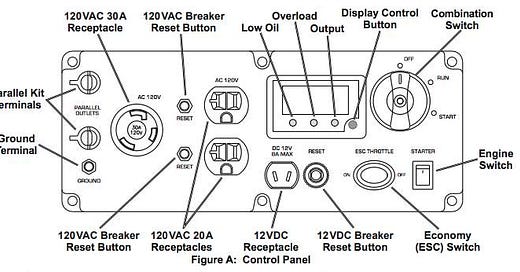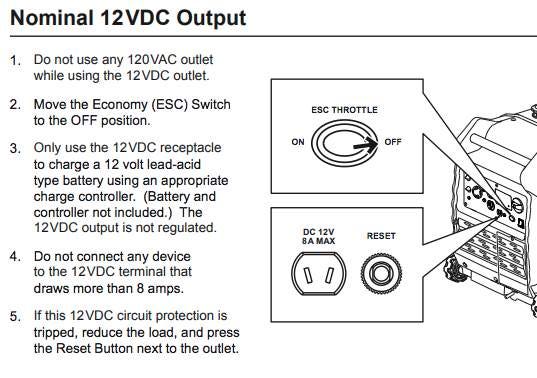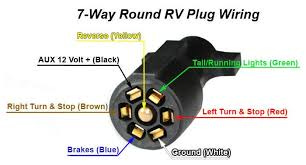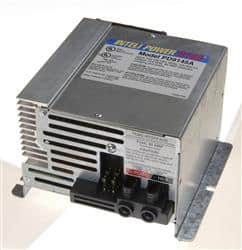Everyone,
This is an extension of my Saturday article about using a generator to charge your RV battery with its shore power cord instead of using the 7-way plug/pigtail. If you missed it, read the article HERE.
Dear Mike,
I have a Predator inverter generator, and have done any battery charging to date via the 110V outputs and a good wall charger (yeah, a little inefficient but easy). The genny also has a 9A “battery charging” plug, which I plugged into for the first time last week just as a DC source – and found it puts out 19 Volts?!? Despite the included cable’s battery clips tempting direct connection, that’s not a good voltage for charging batteries. I found the manual itself says as much, urging the use of a solar charge controller or similar if you actually want to charge batteries from that port. Trivial to remedy with a $30 controller, but you may want to point out to readers this “fry” waiting to happen, as it’s a popular genny… —Wolfe
Dear Wolfe,
Thanks for bringing that to our attention. Yes, many of these inverter generators (including products from Honda and Yamaha) have a 12-volt DC output connector right on the control panel. Looks like a quick and easy way to charge a battery, doesn’t it? But as you noted, that output is not voltage or current regulated, so it won’t properly charge RV batteries directly without an external charge controller.
And also be aware that these generator DC outputs are generally limited to a maximum of 8 or 10 amperes of current. And while that’s not enough for a fast charge on a depleted battery, it’s certainly enough to boil out a fully charged battery pretty quickly since there’s no current regulator circuit. That’s why if you read the manual it states that the 12-volt DC output is not regulated and will require a charge controller for battery charging.
The 7-way plug/pigtail is a poor choice for battery charging
While it might seem like a direct 12-volt connection between the generator’s 12-volt output and the RV batteries is a good idea, it’s actually a poor choice That’s because the AUX 12+ connector is only capable of carrying maybe 10 amperes of current, and most of the time it’s only 5 amperes or so. That’s around a maximum of 60 watts charging power compared to the 1,000 to 1,600 watts of charging power available from the 120-volt output of a 2,200-watt generator.
Use the shore power connector instead
So while it seems a bit crazy, the correct way is to use a generator’s 120-volt output to charge an RV battery is by using a your RV’s 30 or 50-amp shore power connector and charging system. Yes, it’s the charger you already have in your RV. Your RV’s converter is properly voltage and current regulated (or it should be), so your built-in charger will match the voltage and current rate to your battery’s condition and chemistry. The DC output on the generator won’t do that, and will simply keep pumping out the 8 or 10 amps of current, and at a higher voltage than the battery really wants.
And because your RV’s built-in battery charger can utilize up to the full 2,000 watts available from your generator (actually, 1,600 watts in most cases, but who’s counting), on the 12-volt DC side of the converter/charger you could easily be charging your batteries with 100 amps of current (1,600 watts / 14.5 volts = 110 amps). But that’s a little extreme for most RV battery chargers, so the normal 40- or 80-amp battery charger you may already have should work very well powered by a 2,000 watt genny connected to your RV’s shore power cord with the proper 120-volt adapter, no matter what brand generator you have.
Let’s play safe out there… Mike











Thanks Mike, for telling us about the “12V” output on these types of smaller generators. It seems like an accident waiting to happen and a source of liability for the generator manufacturers. I wonder what it actually designed to be used for or does everyone who has one already know they would need to wire in a charge controller? Seems like a bit of a mystery so there must be more to the story.
"Oh, you wanted a steering wheel with that?"
Is a charge controller required to use the 12V output with all generators -- including Honda and Yamaha?
This is the first I've heard about this issue. So the 12V supply is essentially useless without a controller? As Doug said, it seems like "a source of liability for the generator manufacturers."